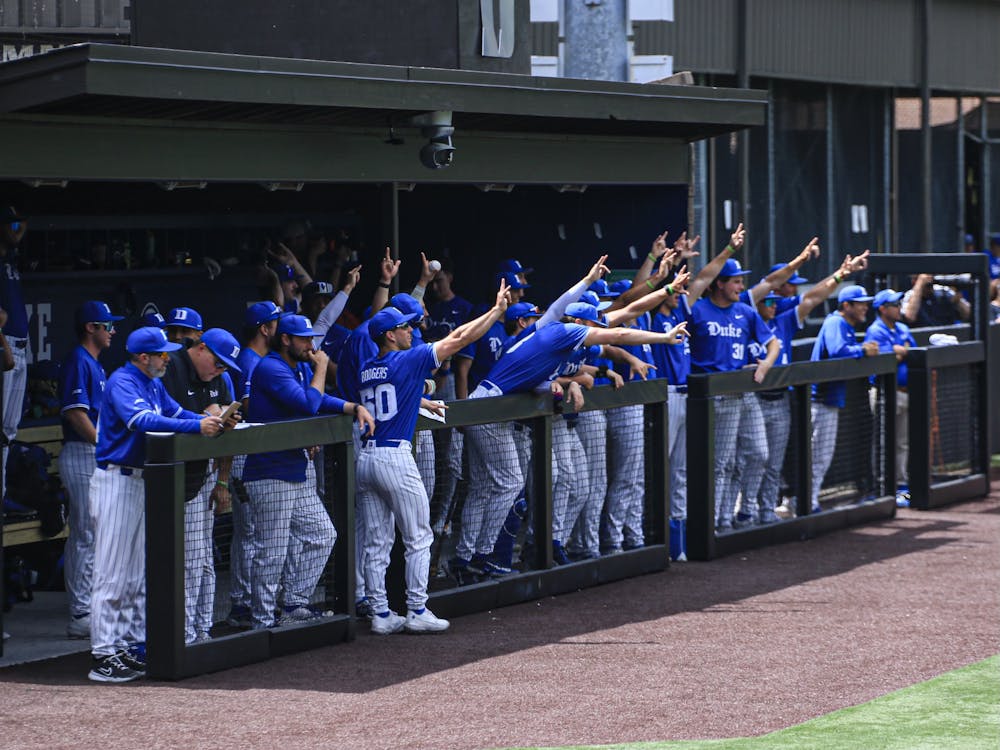On the surface, this iteration of Duke baseball looks eerily similar to last year’s. After all, the two teams finished with nearly identical conference records and rankings, and a grueling gauntlet of ACC opponents caused both to finish the regular season on a sour note.
However, six of the Blue Devils’ eight regular starters in the field did not play for Duke last season, and while there is more pitching continuity, neither of the Blue Devils’ top two starters pitched in last season’s postseason run.
This speaks to the culture built by head coach Chris Pollard, but it also makes it far more difficult to assume winning an NCAA Regional is a foregone conclusion. With that being said, despite the drastic changes in roster composition, Duke is positioned to go far — even more so than last year.
The most substantial difference has been the emergence of ace Jonathan Santucci, and the steady production of freshman Kyle Johnson behind him. Santucci was projected to be the No. 1 arm for the Blue Devils last season, but an early injury sidelined him before he could ever get going. In 12 starts this year, the southpaw has notched 86 strikeouts and allowed just a .186 opponent batting average. However, he is currently coming back from a rib injury that sidelined him for the final two regular-season series. Johnson, a two-way player that has also hit .295 in 61 at-bats, gives Pollard a Saturday starter that he can rely on.
Santucci has gone at least five innings eight times this year, and Johnson’s durability has steadily increased over the course of the season. When it comes to the double-elimination NCAA Regional, it is imperative to not only have a shutdown ace, but also have enough other arms to advance past the opening games.
Duke’s starting pitching is a far cry from last year’s amalgamation of bullpen arms that allowed Pollard to keep opponents on their toes, but also drastically increased gameplan volatility. With two high-quality starters and adept arms behind them, the Blue Devils can enter a Regional or Super Regional environment with far more confidence.
On the other side of things, Duke has put together a lineup even stronger than last year’s, which produced multiple MLB draft picks. Every member of the starting infield is a transfer: Zac Morris and Ben Miller are mainstays at the top of the lineup (and have some killer mustaches), Logan Bravo leads the team with 17 home runs and Wallace Clark is second on the squad among qualified batters in on-base percentage at .451. Combined with Johnson and fellow freshmen AJ Gracia, and returners Devin Obee and Alex Stone, the lineup has hit an impressive .313 this season — good for third in the ACC and over 30 points higher than 2023.
What makes the Blue Devils’ bats especially dangerous is the fact that they still have room to improve. At various points of the season, different pieces of the lineup have been on and off. Miller got off to a blistering start that saw his average climb more than .400 for a stretch, but he has cooled off slightly as of late, totaling just two hits in series against ranked opponents Florida State and North Carolina. On the flip side, Stone struggled to get going early on, but has returned to form and is currently riding a 12-game hitting streak.
So, while there certainly cannot be an expectation for Duke’s entire lineup to get hot simultaneously, it’s hard to imagine a ceiling for the team if it does. In the postseason, teams will have to choose which hitters to prepare for with limited prep time, creating the opportunity for other sluggers to take advantage.
No team is perfect, though, and the Blue Devils are certainly not free of flaws. While the lineup notched 100 home runs, it was also susceptible to the strikeout, as Duke batters were sat down 472 times. They faced no shortage of high-quality arms in the regular season, but the velocity and command of opposing pitchers will only increase as the Blue Devils advance in the NCAA tournament.
More concerning is the inconsistency of the bullpen. Sophomore James Tallon and junior Fran Oschell — two of the best relief pitchers in the nation last season — each have ERAs over 6.00 this season. While others have stepped up, namely graduate Charlie Beilenson, Pollard’s choices at the ends of games are limited. Beilenson has repeatedly notched multiple-inning saves, and while it is a luxury to have a player capable of shutting down a game, that quantity of production is not sustainable over the course of continuous must-win games.
Taking the Blue Devils’ strengths and weaknesses together, the path to Omaha for Pollard’s squad is clear. Ride the top of the rotation, get production out of a capable lineup and manipulate as many quality innings out of the bullpen as possible.
If that sounds easy, it is not.
However, Duke has myriad experience in close games against ranked opponents, as the ACC was as loaded as ever this season. The Blue Devils played six ranked series over the course of the year, five of which were against top 10 teams.
Pollard has been knocking on the door to the College World Series for years now. This just might be the squad that can bust that door down.
Get The Chronicle straight to your inbox
Sign up for our weekly newsletter. Cancel at any time.
Dom Fenoglio is a Trinity junior and a sports managing editor of The Chronicle's 120th volume.

